October 2018 Independent Eating and Drinking Newsletter
| Mealtime
Partners, Inc.: Providing a Bridge to Greater Independence |
October Topics: |
 |
|
| Subscribe to Newsletters |
How to Make Drinking Through a Straw Easier
Many people must drink through a straw to be able to drink with relative independence. Without a straw, they would need someone to lift a cup to their lips and tip the liquid into their mouth. However, some people struggle to use a straw to drink. The second article in the Mealtime Partners July 2018 Newsletter provides information about the different types of straws that are available and why some are more appropriate than others for people who have oral motor difficulties that limits their ability to suck. This months article will provide insight into how a drinking system can be more easily accessed if it is positioned to reduce the need for suction.
To begin with, we should discuss how drinking through a straw works. (This is for those of us who have forgotten what we learned in high school physics class.) If a straw is put into a container of water the surface pressure on the water in the container and in the straw are the same. When you put your mouth on the straw and close your lips, you can create a vacuum in your mouth and reduce (or remove) the air in the straw. When that happens the atmospheric pressure on the surface of the water in the cup pushes the liquid upward into the straw, filling the space that had air in it with liquid from the container. If you continue sucking on the straw, the liquid will fill the straw and then enter your mouth. If you keep your lips sealed, enough liquid will enter your mouth and make you need to swallow. This process can continue as long as you keep your lips sealed around the straw and continue sucking.
When reading the previous paragraph you most probably envisioned a regular disposable straw, but the process could occur with any kind of straw. Could you drink in the same way if you had 2 or 3 regular straws taped together? The answer is, “Yes”, if you have strong enough suction. You might conduct some of the following experiments yourself; your children might find them interesting and fun. In anticipation of writing this article, we tried sucking through a 7-foot tube – positioned vertically. We put a bottle on the floor and stood on a chair to drink from it. It took 3 strong sucks to bring the liquid all the way up the 7 feet. However, once the liquid filled the tube it was easier to continue drinking. The problem is that once you stop sucking, the liquid falls all of the way back into the container and you must suck several times before you get liquid up to your mouth again. Once we sat in the chair, rather than standing on it, and sucked, filling the tube became much easier. It still took more than one suck to get the liquid flowing but it was much easier than when the tube was fully extended vertically. Next, we moved the bottle to a table surface that was almost level with the mouth of the person drinking. At this point, once the liquid filled the tube it did not run back into the bottle when suction was stopped. In this position, stopping and starting drinking was easy. Even though we were drinking through 7 feet of tubing, it seemed to be the same as drinking through a regular disposable straw.
The reason we have gone through this exercise is to provide an explanation about installing our hands-free drinking systems on different types of wheelchairs for people who have diverse difficulties with drinking through a straw.
Mealtime Partners hands-free drinking systems include: the Drink Partner Drinking System, the Front Mounted Drinking System, and the Hydration Backpack with Drink Tube Positioning. Within each drinking system, there are a range of methods that they can be configured. The second article in this months Newsletter will describe how configuring and positioning these drinking systems can meet the different needs of specific individuals and describe why different locations on a wheelchair can accommodate diverse needs.
| A Hands-Free Drinking System to Meet Everyone's Needs | |
| A hands-free drinking system
can enable everyone with the ability to create suction to drink independently throughout the day. Mealtime Partners, Inc. has several different types of hands-free drinking systems to choose from: the Hydration Backpack with Drinking Tube Positioning; the Front Mounted Drinking System; and the Drink-Partner. They can all be easily attached to a bed or wheelchair and can be positioned to meet the individual user’s need. |
|
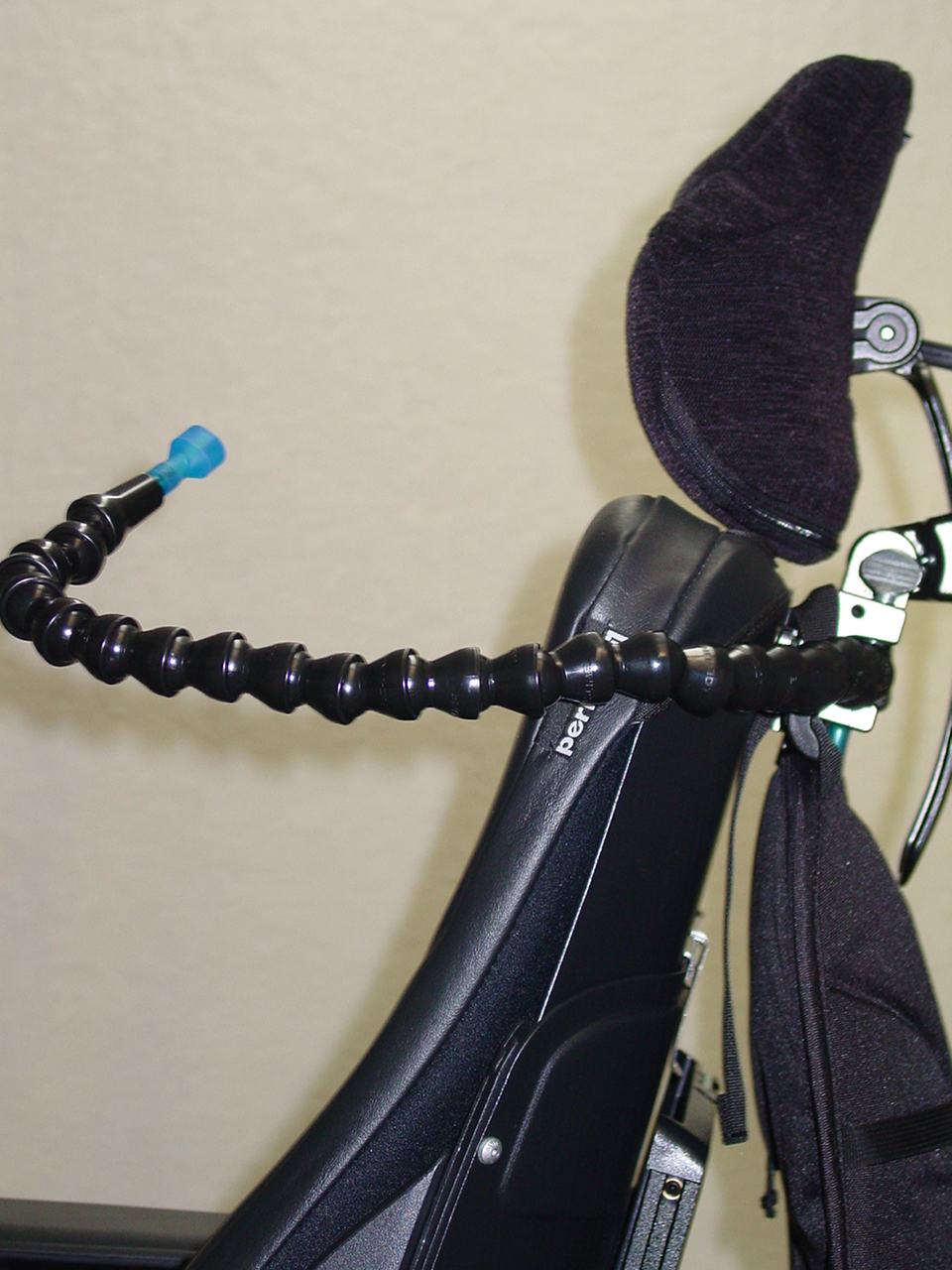 |
|
|
Hydration Backpack with Drinking Tube Positioning (i.e., for Manual Wheelchairs) |
Hydration Backpack with Drink Tube Positioning for Slide Track |
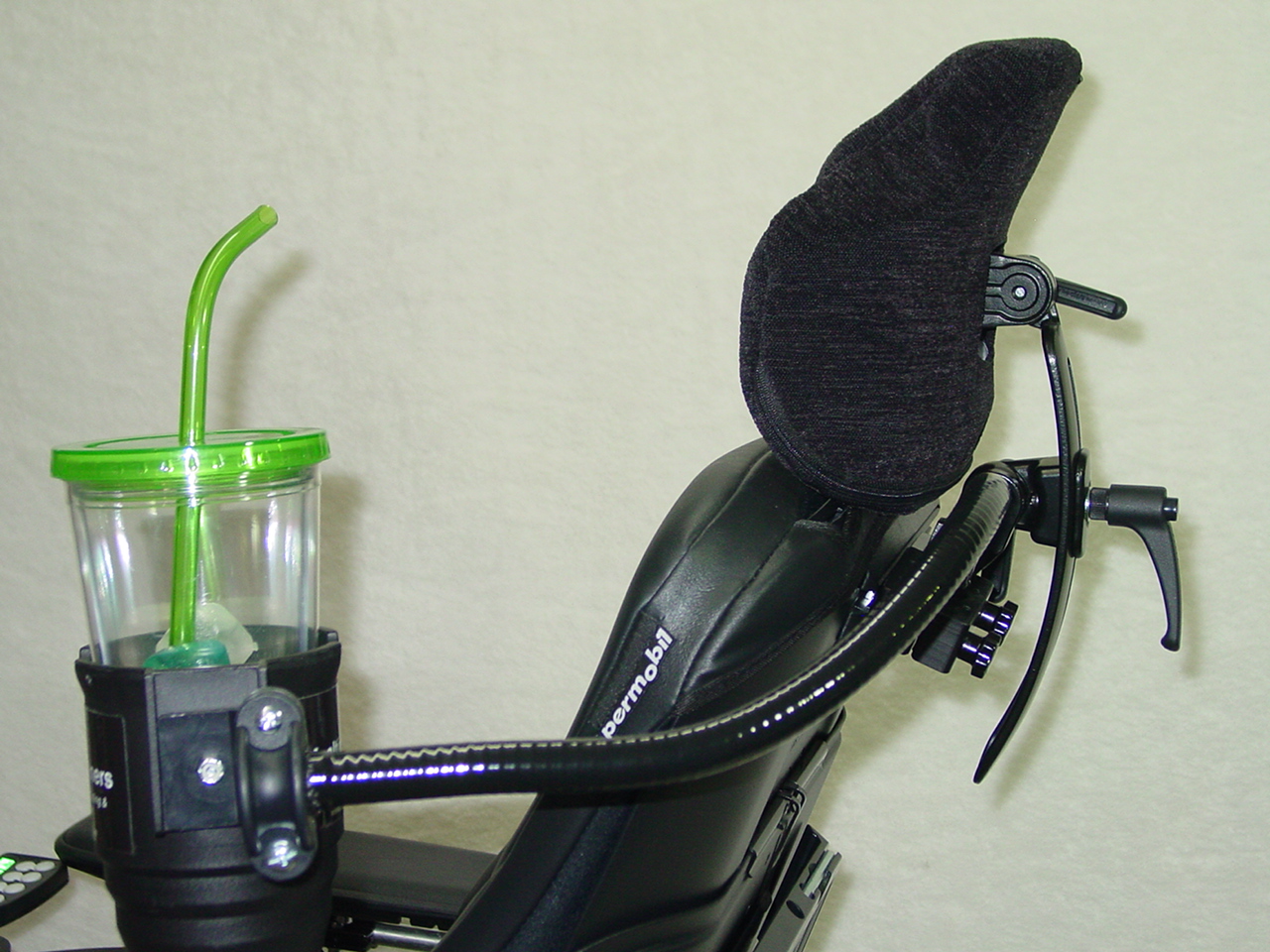 |
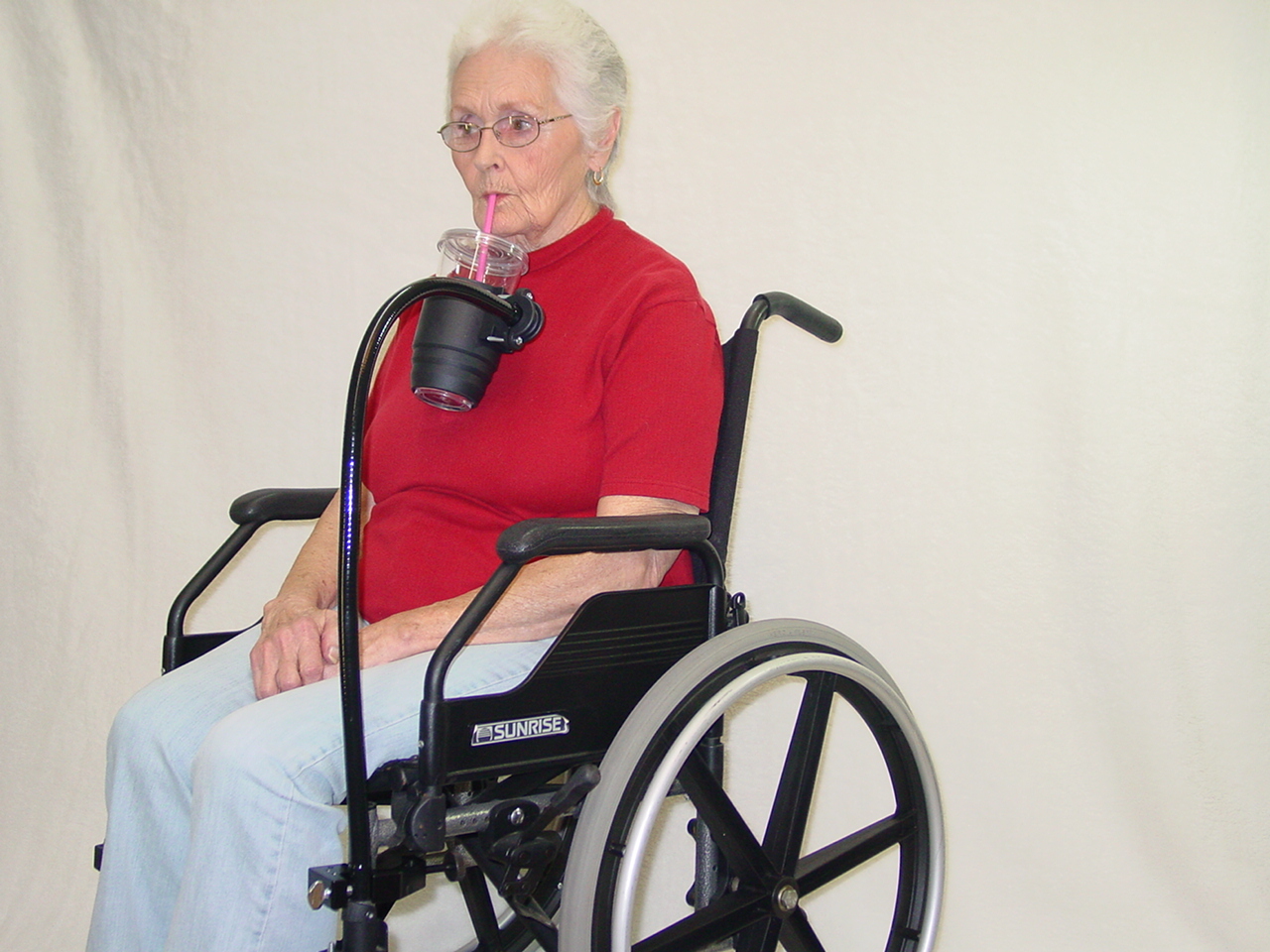 |
| Front Mounted Drinking System for Wheelchairs with Slide Track | Front Mounted Drinking System for Manual Wheelchairs |
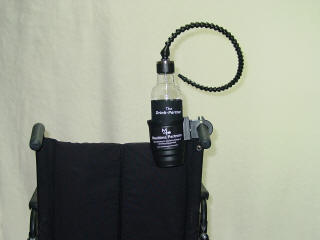 |
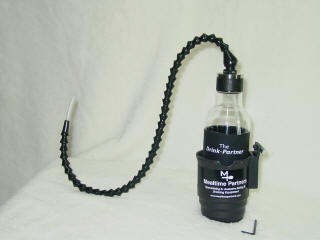 |
| Drink-Partner Mounted on a Wheelchair Handle | Drink-Partner for Slide-Track |
To view all of the Mealtime Partners drinking products, click here. Remember Mealtime Partners drinking products can be attached to powered wheelchairs with slide-tracks, manual wheelchairs with handles and/or tubular frames, or hospital beds with plastic or metal bed rails. For additional guidance about how to select the appropriate drinking system for your specific needs, click here. |
|
Positioning Hands-free Drinking Systems for Ease of Suction
Two of Mealtime Partners Hands-Free Drinking Systems use a cup-holder to mount the drink container from which liquid is being consumed: The Drink Partner Drinking System, and The Front Mounted Drinking System. The third hands-free drinking system offered by Mealtime Partners is The Hydration Backpack with Drink Tube Positioning. This system uses a hydration backpack with its drink tube (i.e., long straw) encased in flex tubing to provide hands-free drinking. The flex tubing allows the drink tube to be held in a position that allows the user easy access for taking a drink. More detailed information about these products can be found in the drinking section of this website.
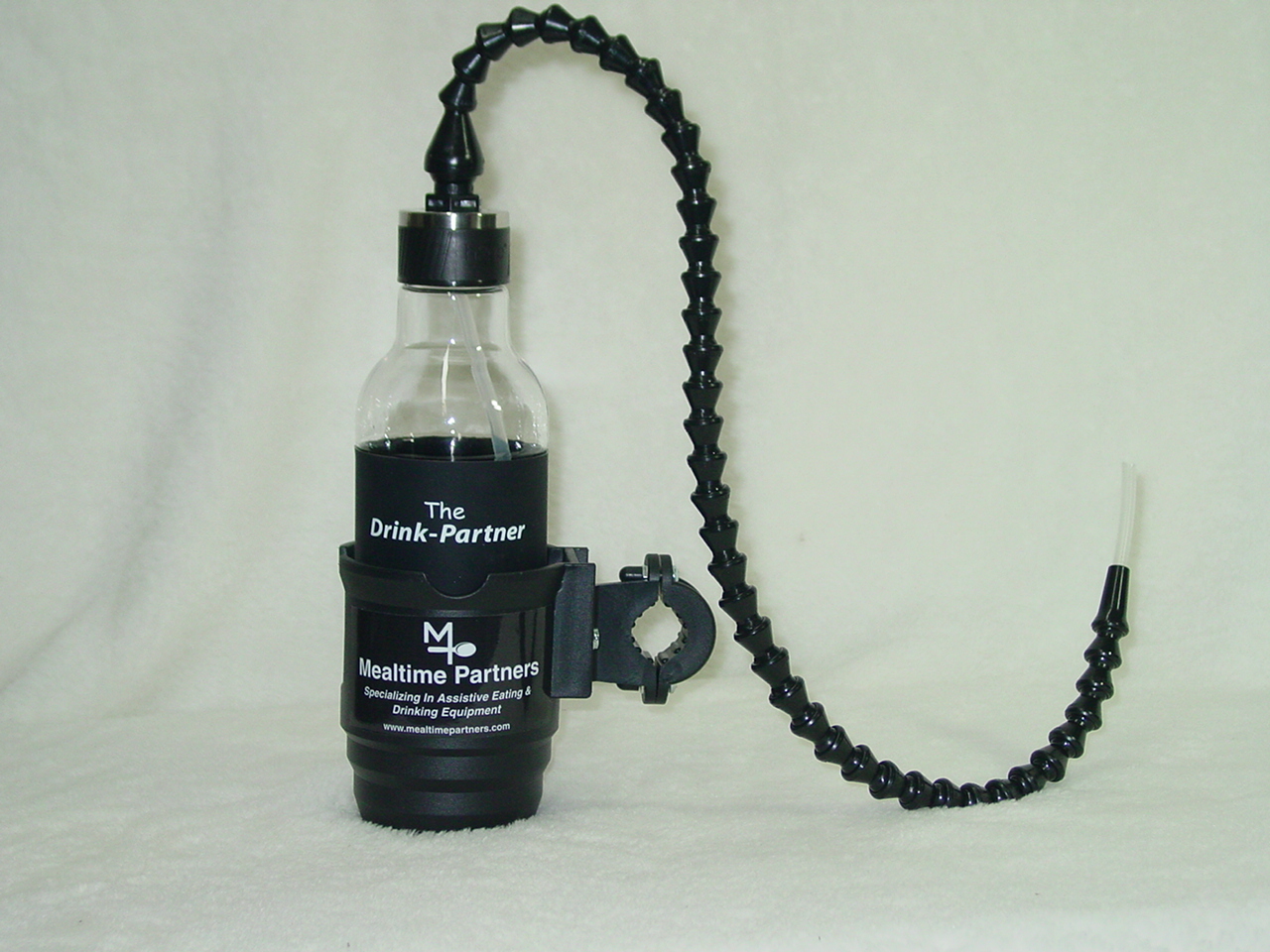
The Drink Partner Drinking System, shown above, is supplied with a cup-holder and bottle. The bottle has a 24-inch long flex tube integrated into its cap. The flex tube holds the (36-inch long) drink tube that carries the liquid from the bottle to the user’s mouth. The cup-holder can be mounted at several locations on a wheelchair (hospital bed, etc). For example, the cup-holder could be clamped to the handle of the wheelchair. When the bottle is inserted into the cup-holder in this location the liquid in the bottle is approximately at the level of the user’s shoulder. The flex tube can be curved over the user’s shoulder and be bent into a U-shape that directs the drinking tube upward towards the user’s lips. Referring back to the experiments described in the first article of this Newsletter, the liquid in the bottle and the end of the drinking tube are on a similar plane and thus sucking liquid may require a small amount of effort for the first sip, but a reduced effort after that, because once liquid has filled the drinking tube, it will not fall all of the way back into the bottle when sucking stops. Instead, it falls to the bottom of the U and remains there until drinking is restarted.
Now consider mounting the cup-holder below the wheelchair seat, either on a slide-track or the wheelchair frame. In this location, the cup-holder and liquid in the bottle are below the user’s thighs. The flex tube can extend vertically from the bottle upward to the user’s lips. Every time the user takes a drink, the liquid must be sucked all of the way up the drink tube. Once sucking is discontinued, the liquid will fall back into the bottle. This location is less noticeable than other places on the wheelchair for the drinking system, which is important to some people. However, it is much more difficult to drink from a bottle located below your trunk and each sip will require a good suck (or two, or three, depending upon the total vertical height) to get the flow of liquid initiated. Therefore, for people with weak suction, it is better to attach the cup holder higher on the wheelchair.
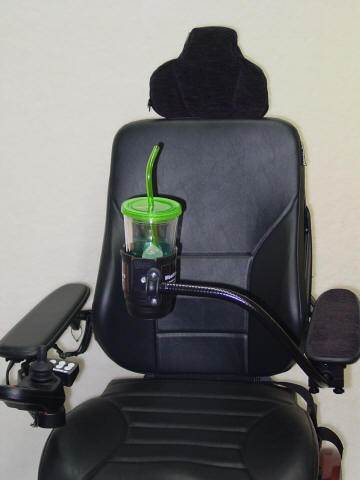
The Front Mounted Drinking System is designed specifically to locate the cup-holder close to the user’s mouth. However, many people choose to use this type of drinking system and do not position the container close to their mouth; instead they move their trunk toward the straw. This drinking system is not supplied with a drink container. The user’s own container is used and is put in the cup-holder and a regular, disposable, drinking straw or a reusable straw can be used to drink from the container. For those who have weak suction, the cup-holder can be positioned approximately level with the user’s chin such that the liquid in the drink container and the tip of the straw are almost level with the user’s mouth. This reduces the amount of suction that is needed to draw the liquid into the user’s mouth. Once again, referring back to the experiments described in the first article, because the height of the liquid in the container and the position of the straw are almost equal, only a small amount of suction is needed to cause the liquid to be drawn from the container into the user’s mouth.

The Hydration Backpack with Drink Tube Positioning holds the liquid that is to be consumed in a bladder that is contained in a backpack. A drink tube runs from the bottom of the bladder out through the top of the backpack. The tube that is external to the backpack is enclosed in flex tubing which allows it to be held in position near the user’s mouth. The end of the drink tubing is fitted with a bite-valve. The bite-valve has a slit in the middle of it, which, when the valve is bitten (i.e., squeezed or compressed), it opens and allows the liquid to flow. So, when the user bites the valve and sucks, liquid flows from the bladder into the user’s mouth. A primary advantage of using one of the hydration backpacks is the large volume of liquid they can hold: 70 or 100 fluid-ounces depending upon the model selected. The backpack is mounted on the back of the wheelchair and the flex tubing extends over the user’s shoulder and is curved to allow the bite valve to be below the user’s mouth and directed upward to avoid dripping from the bite valve. This drinking system is more difficult to suck and drink from than the other two hands-free drinking systems described earlier. Yet, for people who have used this type of drinking system prior to an injury or illness, it is familiar and can, in some cases, be easier for them to use. For those who have oral motor difficulties, or weak suction, this drinking system may be difficult to use and one of the other drinking systems may be more appropriate.
If you are not certain about which drinking system would be the best match for you or your care recipient, or if you are uncertain where to locate it on a wheelchair, please call a representative at Mealtime Partners 800-996-8607 to discuss the requirements. The following link provides more information about Mealtime Partners drinking systems: Drinking.
|
Did You Know? Did you know that baby teeth can reveal significant information about environmental exposure? For years, blood tests have been used to see if someone has been exposed to toxic metal, like lead, or other metals and chemicals. Now Dr. Manish Arora, working at the Icahn School of Medicine, Mount Sinai Hospital in New York, has discovered that teeth can provide information about, not only what the individual was exposed to, but also when the exposure occurred. Teeth start to develop prior to birth and day by day, a growth line is formed in the tooth. At birth a significant line occurs, known as the neonatal line. Because teeth form these lines (similar to a tree having growth rings), a history of the environmental exposures can be identified. In some cases, exposure to toxic substances occurs prior to birth, which means that pregnant women living in polluted areas can unintentionally expose their babies to pollutants in the environment. Dr. Arona is working to identify the impact of numerous chemicals on the health of the population. He, and other scientists from throughout the world, is using this newly identified method to pin point which chemicals, and what time frame (age) of exposure trigger a range of illnesses. This information will lead to a greater awareness of what to avoid, when. Reference: Rachael Cernansky: “What Baby Teeth Reveal” Discover, June 2018 |
Please send comments and suggestions to newsletters@mealtimepartners.com
Copyright © Mealtime Partners, Inc. 2018
All rights reserved
.